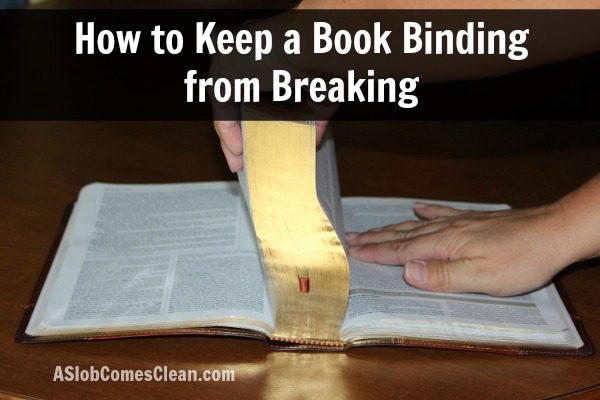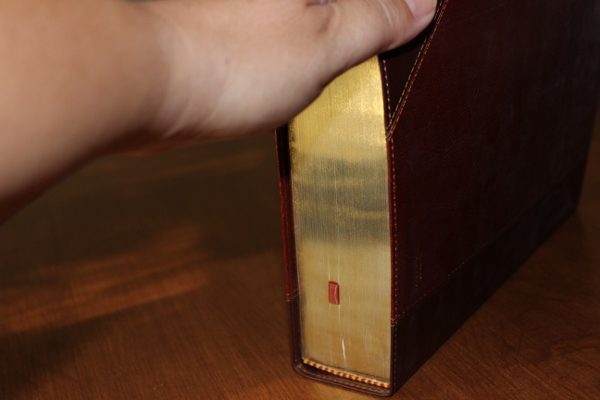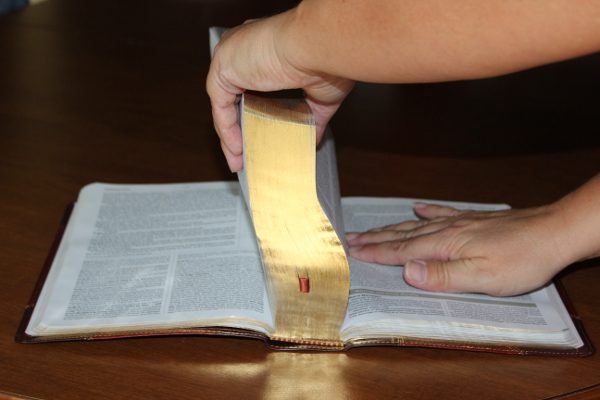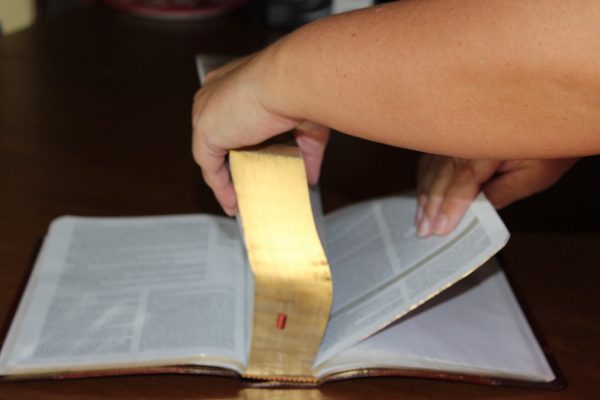
Hmmm. That title is a mouthful.
There are some things my husband has taught me, and some things that I have taught him. Marriage helps you see firsthand that not everyone’s mama teaches her kids the exact same stuff.
When my husband lamented that chunks of pages were falling out of a fairly new (and expensive) Bible a few years ago, I asked him if he broke it in before he used it.
His look of suspicious bewilderment helped me see that “how to break in books” was not something his mama taught him.
My mother taught me when we purchased a set of encyclopedias. She stressed the importance of breaking in a book properly so it will last.
Making things last is a nice companion concept to decluttering. Don’t you think?
So in case your mama didn’t teach you the importance of breaking in book bindings, I’ll share instructions here. In these pictures, I’m using a brand new Bible Hubby had purchased using some birthday money. A brand new Bible that I asked to break in for him so I could take pictures and write a blog post.
A brand new Bible that he had asked about, but that I found a few months later . . . still in its box . . . at the bottom of a decluttering project.
Blech.
(Please note that he had been patiently using his old, falling apart Bible while he waited on his crazy-blogger wife. That’s one awesome and supportive husband.)
Anyway. Here’s how you break in the binding on a book.
Please note that it’s important to do this the VERY FIRST TIME you open the book. With paperbacks and Kindle books, this is a lost art, but when you DO spend a lot of money on a traditionally bound book, you want that book to last as long as possible.

Hold the book with the binding on the table. Bring one side of the cover down to the table, and run your fingers down the inside of the cover, as close to the binding as possible.
Repeat on the other side.
Take a small chunk of pages on the other side, and again run your fingers down them, as close to the binding as possible, gently pressing the pages toward the table.

Repeat on the other side.
Repeat.
Repeat some more, alternating sides each time.
It’s simple, time-consuming, and surprisingly satisfying.
Did your mother teach you how to do this?
--Nony

Nope. I just learned something new. Thanks!
My mother taught me to do that, too. I’ve gotten some odd looks from people who saw me do that. What on earth was I doing?!
Awesome hubby, BTW!
My momma didn’t show me this, but one of my best friends has worked for our public library for years & showed me this right after she started there. Another PSA is that not only is your library a wealth of knowledge in book form, but many of them can direct you to people in your area that can repair book bindings. So if you have a beloved tome that you did not ‘break in” and it’s falling apart, ask! 🙂
Oooh, that’s a great tip!
We learned it in school when we got our textbooks in first grade. And second grade. And third grade. And.. and…
And my great aunt who gave us books for Christmas every year showed us too.
I was taught to start page by page for the outer quarter of the book, then every three or four pages, then up to ten till the center of the book.
me too. learned in 1st grade
I love how your husband waited several months to get his new Bible just so you could do a blog post on it. He is so patient! 🙂 I have heard of breaking in a new Bible but had never done it that way. We just were really careful until all the pages no longer stuck together then we officially proclaimed the Bible as broke in. This is a great post and I’ll have to show my kids your method with their next new Bible.
I didn’t know that! Thank you for sharing!!
Wow, I’ve learned something new and I have a gazillion books plus one.
I saw someone doing that in college, but I didn’t realize it was actually a “thing”. Seems like it would be something they would tell you at bookstores when you drop $200-$300 per book.
Hmm. I didn’t learn this from my mother, or my book-loving aunt…or anyone else. If they taught it in school, it must have been to students who actually got the books when they were new. Great information. I’ll have to remember it the next time I buy a bible…or hardbound book. 🙂
My Mom didn’t teach me. My Dad taught me. Although both of my parents loved books the way I do, my Dad taught me to respect the books that you have – break them in, don’t throw them around, and it you’re not going to keep them, share them with someone who loves them as much as you do.
Nobody taught me this (that i remember), but I have such a HUGE issue about not breaking the binding on the spine and having NO CREASES on the spine that I sort of do this naturally. I’m a freak about my books (even cheap paperbacks) and it is very rare that you can tell I’ve ever opened the book when I’m done with it.
But, I’m so happy to see my need for nice binding has actual merit in the real world. 🙂
Didn’t learn this either, but will try it from now on! Great hint!
Ohhhh, so maybe THAT”s why all of my culinary classmates’ books were falling apart after only one semester. Never heard of that until about two weeks ago….
I had learned this a long time ago, and totally forgot about it. I remember watching my mom break in the encyclopedias. I was very small and not allowed to help. I’ve never seen it since then. Thanks.
And yes, it does relate to decluttering. 🙂 If you are only going to keep the special things, please take care of them well.
I’ve heard of this before but never actually done it. Usually my Bibles fall apart on the outside before they start losing pages. I suppose that’s because I tend to get hardback rather than leather-bound?
“His look of suspicious bewilderment …” This made me chuckle! I love the way you write!
I also had not heard of breaking in a book and will definitely be putting the information to use and teaching my kids as well.
I remember breaking in textbooks as a class in grade school. Good thing to know. Now I need to teach my sons, so this technique isn’t lost in the next generation.
My dad taught me, but my husband had never heard of such a thing. We were also NEVER allowed to eat while reading or write in books.
Never heard of this before, and I am a voracious reader. So glad I now know how to take care of the next book I get. Thanks, Nony!
I had no idea but I’m glad to know it for future use!
We were taught this in grade school, when we received new textbooks. Thanks for the reminder though!
I had never heard of this either. And my parents and I are all avid readers.
I don’t remember being taught this particular book break-in method as such, but I remember as early as second grade, [our school-supplied books were RARELY NEW] our teachers would direct us from the beginning of school & thereafter well into the semester, to follow along the lessons from the beginning of the book, to also flip back & forth regularly from table of contents, to chapter topics, to reference the index frequently, gradually progressing through the textbook or reference books, though not necessarily page 1 through to the end in exact order. I was taught to treat books & all our home & school property [ especially if borrowed/loaned] not just books, but school-owned expensive band instruments too, with great respect and gentle care. They HAD to last a very long time!
I have never heard of this but consider my mind blown. I can’t wait to implement this in my life.
This is a first year Cub Scouts requirement. Thanks for the reminder. Just shows how important Boy Scouting is 😉
I’ve never heard of this, even though my mother has been a librarian since the early 1960s. Still none of my bound books have ever fallen apart. Could it be that books are bound differently here (the Netherlands / Europe)?
I have inherited some old books that were not broken in properly. I tried this method on one of them but the binding broke anyway. Is there a way I can prevent it from breaking on the other books when I open them.
No, I’m so sorry! I’d ask your local librarian.
First time hearing this but it makes perfect sense. Thank you.
Funny, I’ve been doing this for years, but not really knowing that I was helping the book! It just makes it a lot easier to read the book because the pages don’t want to flop to one side or the other. Good to know!
WHAT!!! I am a book lover from a family of book lovers and none of us had ever heard of this! My dad and grandma just insisted that books shouldn’t be opened too wide if you don’t want the bindings to break. 🤦♀️
Also, I’m shocked that so many people learned this in school! I attended 7 schools in 2 states and 2 different countries and NONE of them taught this (and I’m the kind of person who would have absolutely remembered and done this religiously had I learned it).
Anyway, thank you!!! (Several years later).